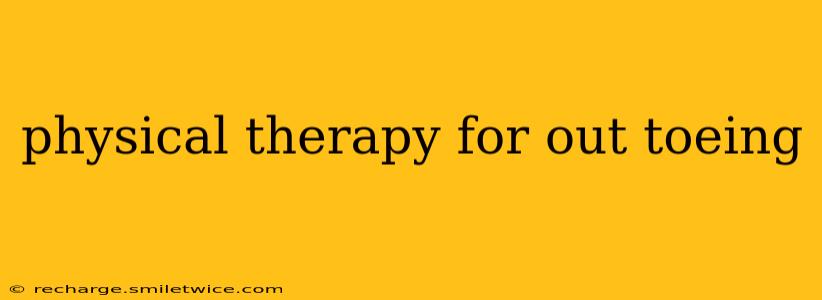Out-toeing, also known as external tibial torsion, is a condition where the feet turn outward when walking. While often harmless, particularly in young children, persistent out-toeing can affect gait, balance, and even lead to discomfort or injury later in life. Physical therapy plays a crucial role in addressing out-toeing, offering a non-invasive approach to improve alignment and enhance overall lower limb function. This guide explores the various aspects of physical therapy for out-toeing, addressing common questions and concerns.
What Causes Out-Toeing?
The causes of out-toeing vary depending on age and underlying factors. In infants and young children, it's often due to the natural position of the feet in the womb or a temporary position held during development. However, persistent out-toeing beyond a certain age can stem from various issues, including:
- Metatarsus adductus: A condition where the forefoot turns inward, often causing the heel and the rest of the leg to compensate by turning outward.
- Tibial torsion: A rotational deformity of the tibia (shin bone), where the tibia twists, resulting in outward rotation of the foot.
- Femoral anteversion: A twisting of the thigh bone (femur) which can lead to both in-toeing and out-toeing depending on the degree of twisting and other factors.
- Neurological conditions: Certain neurological conditions can affect muscle control and lead to out-toeing.
- Hip or foot deformities: Structural issues in the hip or foot can also contribute to outward rotation.
What are the Symptoms of Out-Toeing?
The primary symptom of out-toeing is the noticeable outward turning of the feet when walking or standing. However, associated symptoms might include:
- Gait abnormalities: An awkward or unsteady gait is common.
- Tripping or stumbling: Increased risk of tripping or stumbling due to altered foot placement.
- Knee pain: In some cases, out-toeing can lead to knee pain.
- Hip pain: Similar to knee pain, discomfort in the hips can also be a consequence.
- Foot pain: Pain in the feet can stem from abnormal weight distribution or strain on specific muscles and joints.
What Does Physical Therapy for Out-Toeing Involve?
Physical therapy for out-toeing typically focuses on improving flexibility, strengthening specific muscle groups, and correcting gait patterns. The treatment plan is customized based on the individual's age, the severity of out-toeing, and any underlying conditions. Common techniques include:
- Stretching exercises: These focus on stretching tight muscles that contribute to outward foot rotation, such as the hip rotators and calf muscles.
- Strengthening exercises: Exercises targeting the hip abductors (muscles that move the leg away from the body) and other stabilizing muscles in the hip and leg are essential for improved alignment and gait.
- Proprioceptive exercises: Activities that improve balance and coordination, helping to enhance body awareness and control.
- Gait retraining: A therapist guides the individual to walk with improved foot placement and reduce outward rotation.
- Orthotics (in some cases): Custom-made shoe inserts can support the feet and improve alignment.
Does Physical Therapy Correct Out-Toeing Completely?
The effectiveness of physical therapy in correcting out-toeing varies depending on the cause and severity. In many cases, especially in younger children, physical therapy can significantly improve alignment and gait. However, for severe cases or those caused by significant structural abnormalities, surgical intervention might be necessary. Early intervention is key to maximizing the positive outcomes of physical therapy.
How Long Does Out-Toeing Physical Therapy Take?
The duration of physical therapy for out-toeing depends on various factors, including the individual's age, the severity of the condition, adherence to the treatment plan, and the overall progress. Some individuals may see significant improvement within a few months, while others may require longer-term therapy. Regular sessions and consistent home exercises are crucial for optimal outcomes.
What are the Exercises for Out-Toeing?
Specific exercises are tailored by physical therapists based on individual needs. However, some common exercises might include hip internal rotation stretches, strengthening exercises for hip abductors, and balance exercises. It's essential to consult a physical therapist for a personalized exercise program. Improperly performed exercises can potentially worsen the condition.
When Should I See a Doctor or Physical Therapist for Out-Toeing?
If you notice your child or yourself consistently out-toeing, especially if accompanied by pain, gait abnormalities, or tripping, it's crucial to consult a doctor or physical therapist. Early intervention can prevent long-term complications and improve the chances of successful correction.
Disclaimer: This information is intended for educational purposes only and should not be considered medical advice. Always consult with a qualified healthcare professional before starting any new treatment plan.
